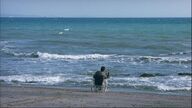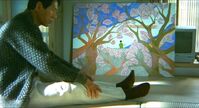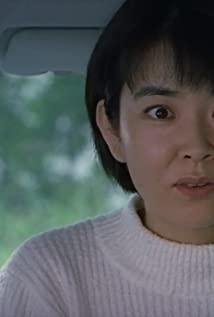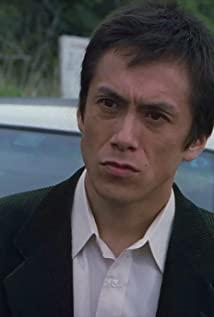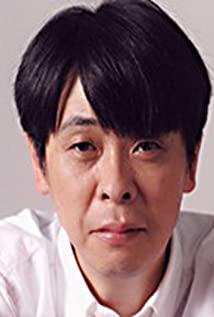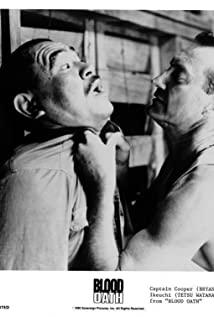"Fireworks" is a 1997 work.
About the director
Kitano Takeshi is a Japanese comic actor who was entrusted by Akira Kurosawa to the future of Japanese movies. He has the face of a gangster and the director of Hisaishi Yoji Yamamoto.
I artificially draw a line of his director's work in 1995.
In 1995, he experienced a car accident that was "stupid to a certain level"¹. When removing the device that crossed the left cheek from his right cheek, he "fully understood the mood of oden." (<( ̄︶ ̄)> Funny)
Before that period, he had been intoxicated in the sweet thoughts of "suicide" several times, and seemed to think he had overcome the fear of death.
When Roland Bart² analyzed a movie image existing in "uninterrupted motion" as a structural object, he defined the "intentional unit" that determines the content of the movie as the "action" set in the movie time. , Rather than "story content and things." He cited the "line of sight" as an example of an action, and the continuation of the action is the change of the "line of sight". According to the "long" and "short" of the time when the eyes of men and women meet, the meaning of the action can be read from it. We compare the actions repeated many times in the movie, and read the meaning of their "meaning in opposition".
In Kitano Takeshi’s early works, “death”, especially his own “death” was repeatedly photographed, but it did not point to sadness. This “repetition” was connected with the anxiety of “life” and tended to be “dead”. hapiness. These blue-tone images are calm and violent.
But after escaping from the car accident, he has since "lost interest in life", not that life is boring. To be precise, he cherishes life more, "just the indifferent mood that he can die anytime" ¹.
The impact of this motorcycle accident on his outlook on life and death is reflected in the subsequent film (or maybe I am trying to catch the wind). At the end of the 1996 comeback, "Bad Boy's Sky", Xiao Ma and Xinzhi had a dialogue.
The painting of Horibu's desire for life in "Flower Fire".
Is he getting rid of the buds of repeated "suicides"?
About the title
Flower fire (はなび)) is Japanese hanabi, but the poster says HAN A-BI
Hana is the Japanese flower, bi is the Japanese fire, and hanabi is the firework. Flower for life, fire for death. But whether flower, fire, "flower fire", or life or death, they are all short-lived.
The images echoed in the film, snow melts easily, cherry blossoms fall easily, fireflies are easy to die, kites are easy to break, and the lives of friends...
At the same time, flowers are gentle and fire is violence. It also echoes the character traits of the protagonist Xi Jiajing.
About gunfire
I have a lot to say about the gunshots at the end of the film. I don’t know if they also caught your attention.
This is the ending of a director who tempts and flirts with the audience, but is actually incomprehensible. I think so for two reasons.
1) As I mentioned earlier, Akira Kurosawa praised Kitano as the future of Japanese cinema, saying that his films "have no extra explanations" and praised him for cutting narrative lines and images to a minimum, in order to criticize the previous Japan. The movie "too much description".
At the same time, Mr. Kurosawa also believes that the final scene of "The Quiet Sea That Summer" (Takako handling the surfboard and Shigeru summer's memories) is "superfluous".
(I have to say that Hiroko Oshima is completely in my aesthetics. I can praise this sister for 100 years)
Although Kitano added that this was a "gift scene", he was worried about the movie that he omitted the psychological explanation (the straight male director is known to be very unconfident in his lyrical scenes), which prompted him to make adjustments to seek the audience's understanding.
But the words of the master had a lot of influence on his future creation, so in "Fireworks", he no longer made the adjustments that the audience expected, but ended the film with two gunshots. As for who fired the shot, who killed, why two shots, two people killed, or even, was it really the shot fired by the person in the film?
Just leave it to the audience to imagine. After all, Thomas Foster³ also said that the audience’s “imagination can provide any picture needed...we audiences are good at this”.
2) The second point is related to music. When I, like most viewers, thought that Xijiajing shot his wife and shot himself, and was immersed in the heavy sorrow of a sad life, I clicked on NetEase Cloud and wanted to recall the original soundtrack made by Hisaishi Rang. I really want to ask Kitano: "Are you kidding me?"
Michel Sion divides the sound in the movie into three types⁴. First, the sound attached to the image is divided into "in-picture/out-of-picture", and the sound that occurs in the same space in the movie screen is "in-picture". "Sound"; even if it does not appear inside the influence, the situation where the sound is uttered in the same space is regarded as a "voice-over". The situation where the space and sound in the video belong to different spaces is called "non-narrative".
In fact, these two gunshots can be classified into the ranks of non-narrative sounds, because they were not emitted in the space within the film at all! It comes from the background music of Tha nk You,...For Everything .
(Look at this mean smile)
The film and the music ended after two gunshots, so the gunshot does not necessarily mean the death of the protagonist, it may be that the director "shot" the person playing the music.
Seeing is not necessarily believing, let alone not seeing? (Did anyone see him raising his gun at someone? No)
About violence
"Aesthetics of violence" is an unavoidable word when it comes to Kitano Takeshi's movies. But I'm too long-winded, so I want to talk less.
The viewing experience of "Fireworks" is not very smooth, but there is an indescribable sense of contradiction and violation. For example, the paintings of Horibe in the film (those are paintings of Mr. Takeshi Kitano himself), using flowers to replace the faces of people and animals, the imagination is boundless but full of justifications and distortions of life, doubts about the truth, and the beautiful Deconstruction, thus appears deliberate and abrupt. Kitano believes that the protagonist’s heart cannot be realized through filmic elements such as language and movement. While his films have dramatic elements, their images are full of antinomy that rejects inner depiction.
He inherited the fixed lens of Ozu Yasujiro, and used a large number of characters in the middle and close-range composition of the frame. This stable and balanced composition method and lens selection are in sharp contrast with the life ups and downs of the film characters.
Most of the violence in the fireworks is brought about by the shock of multiple and short shots, but the violence in Xijiajing's memories repeatedly appears in upgraded shots. The plasma quietly repeated the slow jet, and the friend was killed and injured countless times in Xi Jiajing's memory.
The position of the protagonist policeman and the setting of bank robbery are another source of contradiction. The deconstruction and destruction of his identity is an unnecessary burden in his unloading life.
Even better is that his purpose of robbing the bank is to take his terminally ill wife on an endless journey. How can the tenderness of a violent tough guy not be touching? But the lyricism of straight men depends entirely on BGM.
(You can take a group photo, but you can't hold hands)
These are all sources of ambivalence. Violence and beauty are contradictions in themselves. Even criminal young men who attacked the police with guns must be accompanied by colorful flowers.
I know too little, and I write long and general.
Thank you for reading.
If you are also interested in Kitano Takeshi, have a chat with me.
reference book
[1] Kitano Takeshi. Jiang Xiangming translated "Kitano Takeshi's Tavern". New Star Publishing House, 2017
[2] Roland Barthes. "Explicit Meaning and Obscure Meaning". Renmin University of China Press, 2018
[3] Michel Sion. "The Construction of Audiovisual and Illusion". Beijing Union Press, 2014
Ah ah "ありがとう...ごめんね"
—はなび✨
View more about Fireworks reviews



